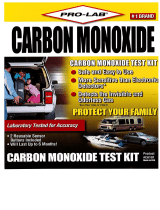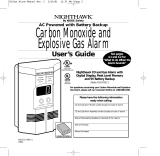Page is loading ...

ENGLISH •Operation •Maintenance
Effective 5/17/01
LITERATURE NUMBER
MPD 38131
hydro flame
TM
SACO-2 Carbon Monoxide Detector
MONITOR
Owner’s Information Manual
GENERAL INFORMATION
The SACO-2 Carbon Monoxide Detector monitors the presence of CO
(carbon monoxide) with an electrochemical sensor. It is not influenced by
humidity, natural gas or LPG (liquefied petroleum gas). It will measure the
concentration of CO between 1-999 PPM (parts per million) with a resolu-
tion of 1 PPM and factors in a small zero float. Typical battery life of this
monitor is 500 hours when used with an alkaline battery. This device can
be used by professional technicians and experts to detect CO build up in
industrial and residential environments. It is able to detect CO in living
areas, garage and around gas burner appliances. The detector will only
indicate the presence of carbon monoxide gas at the sensor. Carbon
monoxide may be present in other areas.
The detector indicates the presence of Carbon Monoxide in two ways:
• By displaying a reading in PPM concentrations of carbon monoxide
on the LCD (liquid crystal display).
• By emitting an audible beep when carbon monoxide is present in
excess of 40 PPM.
GENERAL DESCRIPTION OF CARBON MONOXIDE
Carbon Monoxide (CO) is an odorless, colorless gas that is formed as a
result of incomplete combustion of carbon based fuels (wood, coal, gaso-
line, LP Gas, etc.). When fuel is burned Carbon (C) and Oxygen (O) will
normally combine to form Carbon Dioxide (CO
2
). If there is insufficient oxy-
gen, due perhaps to a restricted air flow, CO is formed. Internal combus-
tion engines and propane gas fired appliances are typical sources of car-
bon monoxide.
WARNING
Actuation of this device indicates the presence of carbon monoxide
(CO) which can be FATAL.
WHEN MONITOR BEEPS:
If anyone has a headache or an upset stomach call the Fire Department immedi-
ately and move to a location which has fresh air. DO A HEAD COUNT TO CHECK
THAT ALL PERSONS ARE ACCOUNTED FOR. DO NOT RE-ENTER PREMISES
UNTIL IT HAS BEEN AIRED OUT AND THE PROBLEM CORRECTED!
If no one exhibits symptoms of discomfort associated with CO poisoning, simply:
• Turn off appliances and other sources of combustion - furnace, water heater,
range (wood, coal or kerosene burning) stove, heater or fireplace, RV, genera-
tor, automobile.
• Call a qualified technician and have the problem fixed before restarting appli-
ances, the vehicle, and other sources of combustion.
• Immediately get fresh air into premises, RV or vehicle.
EFFECTS ON HUMANS
CO is absorbed by the lungs and reacts with blood hemoglobin to form
carboxyhemoglobin (COHb), which reduces the oxygen carrying capacity
of the blood. If the concentration of CO in air exceeds 2,000 ppm, which
corresponds to 0.2%, it can be fatal in a matter of minutes. In smaller
quantities carbon monoxide will cause a series of symptoms such as
fatigue, headache, nausea, dizziness, collapse and eventually death. The
progression and intensity of these symptoms depends on the time of
exposure and the concentration of CO present in the environment.
Many cases of reported CO poisoning indicate that while victims are aware
they are not feeling well, they become so disoriented they are unable to
save themselves by either exiting the building or calling for assistance. Also
young children and household pets may be the first affected.
LEARN AND RECOGNIZE THE EFFECTS OF CO POISONING.
CONCENTRATION
OF CO IN AIR
INSTRUCTIONS
0-1 PPM Normal background levels.
9 PPM ASHRAE standard 62-1989 for living areas
50 PPM OSHA enclosed space 8 hour average level
100 PPM OSHA exposure limit
200 PPM
Slight headaches, fatigue, dizziness and nausea
after 2-3 hours.
400 PPM
Frontal headaches within 1-2 hours, life threatening
after 3 hours.
800 PPM
Dizziness, nausea and convulsions within 45 min-
utes. Unconsciousness within 2 hours.
Death within 2-3 hours.
*PPM = parts per million
U.S. Department of Labor, Occupational Safety & Health Administration (OSHA)
Regulation 1917.24: “The CO content in any enclosed space shall be maintained at
not more than 50 PPM (0.005%). Remove employees from enclosed space if the
CO concentration exceeds 100 PPM (0.01%).”
The table above refers to healthy adults. Anyone with a health condition
may find lower levels of CO more dangerous than shown in this chart.
COMMON SOURCES OF CO
Common sources of potential dangerous levels of CO are:
• Poorly maintained furnaces, gas heaters or fireplaces.
• Dirty or plugged chimneys or flue exhausts.
• Poorly maintained gas, oil or kerosene appliances.
• Internal combustion engines (e.g., automobiles, lawn mowers and
blowers).
APPLIANCE FUEL TYPICAL PROBLEMS
Ranges Natural Gas • Not enough air to burn fuel
Ovens LP Gas • Improperly adjusted burner
• Misuse as a room heater
• System not properly vented
Water Natural Gas • Not enough air to burn fuel
Heaters LP Gas • Improperly adjusted burner
• Misuse as a room heater
•
Systems not properly vented or blocked vent
Stoves Natural Gas • Not enough air to burn fuel
Fireplaces LP Gas • Improperly adjusted burner
Wood • Cracked firebox
Coal •
System not properly vented or blocked vent

FEATURES
• The detector indicates the presence of CO by a reading on the LCD
and by sounding a beeper.
• Large LCD displays CO levels between 0 and 999 PPM.
• Beeper sounds 3 times continuously between 30-400 PPM.
• Above 400 PPM, the beeper sounds 5 times continuously.
• Bright back-light allows easy screen viewing under dim lighting con-
ditions.
• Battery life indicator (fuel gauge).
• Automatic power off after 10 minutes.
• Max mode stores and displays the maximum CO level taken during
sample time.
• CO level beeper can be silenced if desired.
• Sensor malfunction checking.
• 9V battery is easy to replace.
OPERATIONS
1 CO Sensor 9 Battery life indicator
2 LSR (light sensitive resistor) 10 Sensor malfunction icon
3 LCD (liquefied crystal display) 11 Mute beeper icon
4 “MAX” reading button 12 Beeper
5 “ON/OFF” power button 13 Battery connector
6 Concentration of CO reading 14 Battery door
7 Sampling display or 15 Battery 9 volt
ERR - end of useful life
8 Max reading mode icon
BATTERY INSTALLATION AND SELF TEST
1. Open the battery door and install the battery FIG 1.
2. Close the battery door.
3. Turn the detector on by pressing the ON/OFF button
FIG 1.
4. The detector beeps twice, then performs a self-test. The dis-
play shows all the icons then shuts them off and counts down
from 9 to 0.
5. Normal display will show the battery life indicator and the
PPM display amount. A small solid dot will flash every 3 sec-
onds showing that the unit is working correctly.
6. The unit will then be ready to automatically detect CO con-
centration levels.
SELF TESTING
1. The detector will self-test each time the ON button is pushed.
2. If the battery power is below the level required to power the
detector, the detector will emit a beep and show Lb (indicating
low battery) in the display window and the battery icon will show
level or empty bars. This indicates you must replace the battery.
3. If the detector shows Err and the sensor malfunction icon
shows on the display, the sensor has been damaged or failed.
See warranty for action.
ESTABLISHING A BASELINE
1. Before testing for CO, the detector establishes a baseline
against which the detector compares other environments.
2. Do this by turning on the detector in a clean environment.
3. If the detector reads between 0-6 PPM, it does not establish
a new baseline, but starts taking CO measurement.
MAXIMUM READING
1. To obtain the maximum reading of CO press the MAX button,
the beeper emits one chirp and the MAX icon will display in
the top left corner of the display.
2. The reading on the LCD refers to the maximum value, which
has been detected by the unit.
3. After a few seconds the display will restore back to normal
test mode and the MAX icon will disappear.
MUTING THE BEEPER
1. To mute the beeper, press the MAX button for more than 2
seconds.
2. The mute beeper icon will appear on the bottom left corner of
the LCD.
3. To re-enable the beeper, press the ON/OFF button, this will
turn the detector off and then back on.
AUTO BACK LIGHT
1. If the ambient light is too low (making the LCD difficult to
read), the LCD back light will automatically turn on.
2. The back light will automatically turn off when there is suffi-
cient light.
AUTOMATIC POWER OFF
1. The detector will automatically turns off after 10 minutes of
none-use.
SPECIFICATIONS
MEASUREMENT RANGE: ......0-999 PPM, (above 999 PPM display OL)
SENSITIVITY: ....................1 PPM
ACCURACY: ......................62% full scale (at temperature: 70˚F-78˚F (21˚C-64˚C)
RESPONSE: ......................60 seconds @ 90% of final value
TYPICAL SENSOR LIFE:........more than 10 years
BATTERY: ........................9 volt
OPERATING TEMPERATURE:..23˚ F - 104˚ F (-5˚ C - 40˚ C)
OPERATING HUMIDITY:........0-97% relative humidity (non-condensing)
WEIGHT: ..........................5.2 ounce (150 grams)
DIMENSIONS:....................7 x 2.3 x 2” (180 x 60 x 50 mm) approximately
RECOVERY TIME: ..............<30 PPM = 1 min <999 PPM = >2 min.
MAINTENANCE
1. The detector requires no calibration or servicing.
2. If detector does not operate check battery conditions and
replace with new battery.
3. If detector still does not operate properly destroy and discard
the CO monitor.
STORAGE AND SHIPPING
Transportation by sea, land and air is acceptable for this prod-
uct. During shipping, care should be taken to avoid collision,
rain, snow and mixture of corrosive materials. During the loading
and unloading, strictly prohibit the throwing of product. The
product should be stored in a clean room with the ambient tem-
perature of 23
˚ F - 104˚ F (-5˚ C - 40˚ C). Relative humidity of no
more than 95% and free from any corrosive vapors and harmful
impurities in the air.
WARRANTY
Atwood Mobile Products
®
warrants its carbon monoxide monitor
to be free from defects in material and workmanship for a period
of 90 days from the date of purchase by the Original Purchaser.
“Original Purchaser” is that person who purchases a new car-
bon monoxide monitor for his own use. If there is any defect in
the manufacturing of, or failure of any such monitor which is
reported within the aforesaid ninty day period, Atwood will, with-
in a reasonable time and without charge, make repairs and
replacements as needed. In no case shall liability under any
other remedy prescribed by law exceed the purchase price. Your
monitor is not a substitute for Property, Disability, Life or other
insurance coverage: appropriate insurance coverage is the
owner’s responsibility.
/


